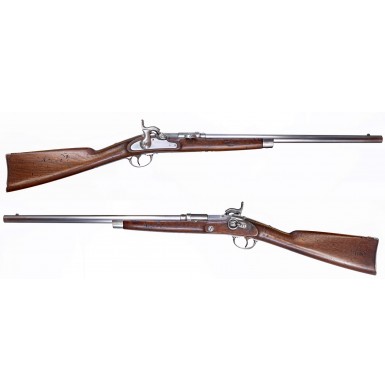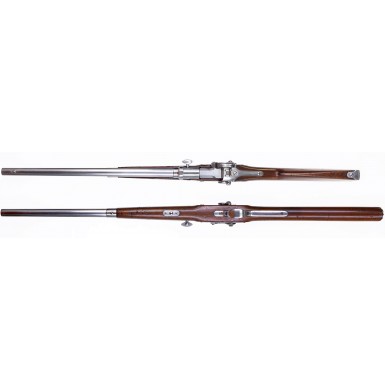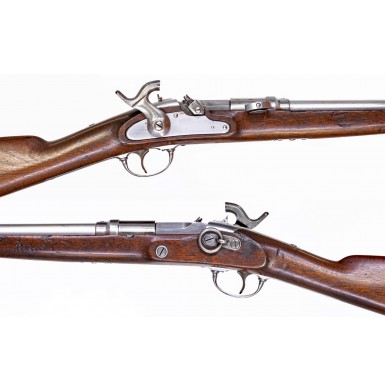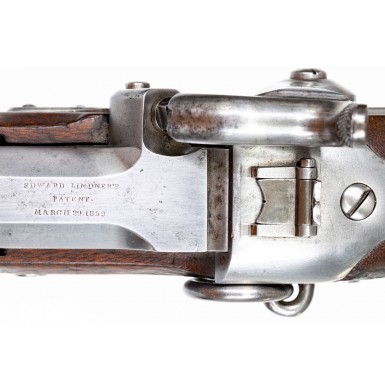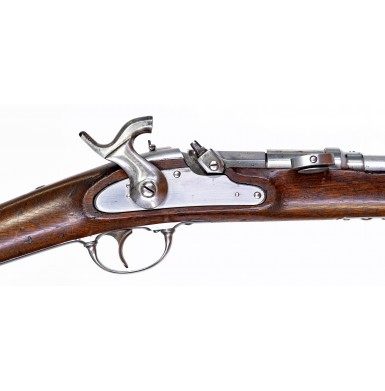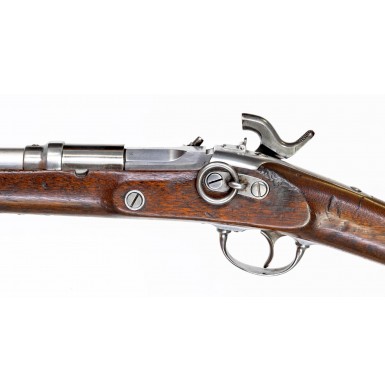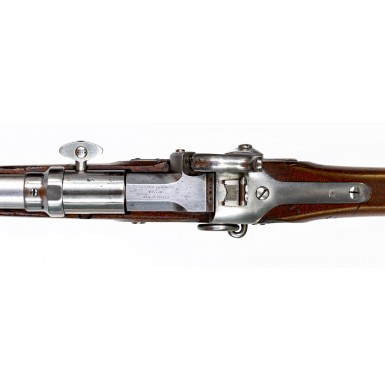Extremely Rare "1st Model" Lindner Carbine - Only 501 Produced and Issued to the 8th WV Mounted Infantry
- Product Code: FLA-4040
- Availability: Out Of Stock
-
$5,295.00
This is a NEAR FINE condition example of one of the rarest and least often encountered breechloading carbines from the American Civil War, the Lindner Carbine. Despite collector terminology that calls the initial production run of Lindner Carbines with blank lock plates that were assembled from contractor provided parts by the Amoskeag Manufacturing Company as “1st Model Lindners”, the true first model Lindners were actually produced by altering Austrian Model 1842 Jaeger Rifles and remanufacturing them into carbines. Some of the work on those guns was performed by Amoskeag, but some was also apparently performed in Europe, where the Austrian arms were initially acquired. The resulting process of obtaining the guns, altering them, and delivering to the US government is still somewhat vague, but we can attempt to follow the dots and watch the story unfold.
The Lindner breechloading system was the invention by Edward Lindner of New York, who received US Patent #23,378 on 29 March 1859 for his design. Lindner had submitted the application on January 10 of that year. However, it took some modifications to his claim, particularly the removal of claims that were covered under previously granted patents to other inventors before the patent was finally granted. Lindner had also received two other earlier firearms design patents prior to the one relevant to his breechloading carbines. In 1854, he had developed a “magazine loading revolving rifle”, but author and researcher Ed Hull notes in his book Lindner Carbines and Rifles – Collectors Guide to the Rarest of Civil War Breech Loading Firearms, the design was simply too complicated to be practical. In 1856, Lindner received US Patent # 14,819 for an automatically opening tilting breech mechanism. The system, similar to the Hall’s tilting breech, was unique in that the passing of the fired ball along the path of the barrel tripped a release that resulted in the opening of the breech automatically when the gun was fired. Lindner had a sample gun altered to use this system and submitted it to the Ordnance Department for testing. However, after test firing the old, altered musket only forty times, it was found the system resulted in erratic accuracy due to the fact that the release mechanism caused motion in the gun while firing, which affected the point of impact. The 1856 design also failed to create a tight gas seal, thus it suffered from the same issues that plagued the then current production Hall’s patent rifles and carbines. Despite this set back, Lindner kept working, and it was his 1859 patent that would achieve a modicum of success with the Ordnance Department.
The 1859 patent covered his breech loading percussion ignition design, which used a hooded rotating bolt collar to lock and unlock the breech, allowing the breech to tilt up under spring pressure for loading in a manner reminiscent of the Hall’s patent rifle. The system was unique and somewhat cumbersome. The mating of the grooved tilting chamber with the hooded collar was intended to provide the gas seal that the Hall did not have. Like any arms inventor, Lindner’s first thought was to obtain government contracts for arms built around his breechloading system. Interestingly, the system had the advantage of being equally applicable to the alteration of existing muzzleloading arms as to newly made ones. This was actually Lindner’s initial approach in submitting his design to the Ordnance Department for evaluation and this fact is one of the underlying themes of the story of the Austrian Lindners.
Lindner submitted a Swiss Model 1838 Engineer’s Musket that had been converted to breechloader by the Lindner system for Ordnance Department evaluation in January of 1859. Between January 22 and 24 the gun was tested, with the design being rejected. The complaints were several, with the first being that the female groove in the tilting breech was likely to become dirty, rusted or fouled, making the operation of the system difficult. Second, the testing officers felt that the gas seal was based entirely upon the tight mechanical fit between the grooved chamber and hooded collar. Should this wear due to gas erosion, rust or any other reason, the resulting gapping would allow the release of gas. Additionally, it was found that the projecting operating handle from the hooded collar was somewhat troublesome both because it stuck straight out from the gun creating an awkward poking hazard, and from the standpoint that it was likely to become broken in the field. The report firmly castigated the design by concluding of the design; “In our opinion it does not possess either the simplicity or durability required for an arm for military purposes.”
But Lindner was not deterred. He approached the Navy for a test of his design. Admiral Dahlgren tested Lindner’s gun by firing it some one hundred and forty times with positive results, although nothing ever came of the testing for Lindner. Lindner also continued to make applications to the army via Secretary of War John B. Floyd and somehow persuaded Secretary Floyd to request the army perform additional tests. This time two altered guns were submitted for review, with at least one of these guns being of Swiss origin again. As before, the arms performed less than spectacularly, with the primary objection again centering around the inconvenient operating handle. Additionally, the fact that the gun had the ability to fire up to five rounds a minute allowed the gun to heat up sufficiently that it made the gun too hot to touch and difficult to operate the breech hood lever. Interestingly, the less than spectacular accuracy delivered by the gun was not considered a particular issue. However, at the conclusion of the report, the testers noted that should Lindner be able to address these design issues that possibly fifty guns should be acquired for further testing.
As the Civil War erupted, Lindner continued to pursue any way to obtain a contract to alter arms to his system for the US government. One of Lindner’s proposals was to alter existing stocks of obsolete Hall carbines to his system, thus eliminating the gas leakage problem inherent in the Hall. Lindner was rebuffed, with the Ordnance Department more interested in selling off the old carbines than modifying them. Interestingly, this set the scene for the Hall Carbine Affair that brought down General Fremont. Arthur Eastman of Manchester, NH also tried to sell the Lindner alteration of Hall carbines, but his offers were rejected too. Eastman subsequently agreed to purchase the old Hall carbines from the government and intended to proceed with the alterations, using the Amoskeag Manufacturing Company’s facilities to perform the work. Eastman had two samples produced, but the again the proposal was rejected by the Ordnance Department. Eastman then decided to cut his losses and sold off the guns to other speculators, who “modified” them to .58 caliber, rifled them and then resold them to the government via General Fremont for a fantastic profit. Lindner was not involved in this sale but was on the fringes of what would become the first large-scale military industrial complex scandal that would launch a Congressional commission to investigate military contracts and war profiteering.
Eastman then took a new approach and proposed altering the flintlock Hall rifles in the possession of the state of New Hampshire to the Lindner percussion system. The governor agreed to the proposal and Eastman had Amoskeag alter two hundred flintlock Hall rifles for the state, charging the state of New Hampshire $10 to convert each rifle. The process took several months, with guns being delivered to Amoskeag in July of 1861 and the work not being completed until the end of November. This delay likely involved making the required jigs and specialized tooling to produce the Lindner breech blocks and collars and suggests that the work was not easy. Upon completion, the state decided not to accept the guns, for a reason that is not immediately known. In the end, the Lindner altered Hall Rifles were sold off to William Read & Son of Boston, at the low price of $11.50, which suggests that everyone involved in this transaction, other than William Read & Son, likely lost money on the deal. The only potential upside was that Amoskeag was now in possession of the necessary equipment to produce the Lindner breech systems.
Another entrepreneur who tried to capitalize on the Lindner design was E.G. Allen of the National Steam Gauge Company in Boston. Allen obtained a Pattern 1853 Enfield Rifle Musket from the state of Massachusetts and paid Amoskeag to alter it to the Lindner system. This was no doubt intended to be a sample to obtain a contract to convert the numerous English rifle muskets that the state was buying from England into breechloaders. This plan did not meet with success, but after the state acquired some four thousand older US Model 1841 “Mississippi Rifles”, Allen managed to obtain three of these to have them altered to the Lindner system as samples for the state. Allen came to a patent royalties’ agreement with Lindner, paying the inventor for the right to use the Lindner patent to both alter guns for the state of Massachusetts, as well as to alter guns in the state of Massachusetts for sale elsewhere. Allen formed the partnership of Morse & Allen for this business venture, but in the end only one hundred and three Model 1841 rifles were altered to the Lindner system for the state of Massachusetts, including the three sample guns. Morse & Allen then managed to obtain two hundred more Model 1841 rifles from the state of Massachusetts which they had Amoskeag alter to the Lindner system. They also added wrist mounted peep rear sights, and then these guns were sold to the “Department of New England”. This “Department” was in fact General Benjamin Butler’s command that had been established to organize the force that would plan and execute the attack, invasion, and capture of New Orleans.
Lindner was somewhat forward thinking and unlike many American inventors had forethought to patent his designs in both Belgium and Great Britain. While he was pursuing potential contracts with the US military in the days leading up to the American Civil War, he had also set up a facility in Hamburg to theoretically perform Lindner alteration work. Lindner had managed to obtain a supply of obsolete Austrian Model 1842 Jaeger Rifles, as well as some Model 1854 Extra-Corps Carbines from the Piedmontese, who had apparently captured them during the 1859 Austro-Sardinian War (2nd Italian War of Independence) with the Austrians. Lindner proposed to alter these guns to his percussion breechloading system, shorten them to carbines and then offer them for sale to the US government. Lindner engaged Samuel B. Smith of New York to act as a sales agent on his behalf. Smith was an active promoter of Lindner’s design, and on 6 November 1861 he acquired his first U.S. Ordnance Department order for four hundred of the carbines. The guns were specifically ordered for issue to the 1st Michigan Cavalry Regiment by the regiment’s commander, Colonel Thornton F. Brodhead. While it has long been reported in various works that these 1st Michigan Cavalry carbines were the newly made “1st Model Lindner Carbines”, that were assembled by Amoskeag from parts delivered by a variety of contractors, this is not correct. The reality is that the first of the Lindner carbines delivered to the US government were produced from altered Austrian muzzleloading rifles. Author and researcher Ed Hull has identified these Austrian Rifles as Model 1842 Jaeger Rifles however it appears that the guns were probably a combination of Austrian Model 1842s and 1842/44s, with a handful of other similar models thrown in.
The Austrian Model 1842 Jaeger rifles that were altered to Lindner Carbines started life as Augustin Consol Lock (“pill lock” or “tube lock”) ignition muzzleloading rifles. Many of the guns were later altered to percussion in Austria after the adoption of the percussion ignition system by the Austrian army in 1854. This alteration included the removal of the external Consol Lock battery, the threading of a bolster into the pill lock touchhole and then brazing the bolster to the barrel. A new percussion hammer, similar to that used on the Model 1854 Lorenz was then typically installed, although in some cases the old Consol Lock hammers were modified for percussion use. As produced, the Model 1842 rifles had nominally 26” octagon to round barrels and were about .60 caliber, and most had four-groove bores. Some other variants appear to have had seven-groove bores. The guns were brass mounted with a semi-pistol gripped, skeletonized triggerguard extension to the rear to enhance the shooter’s grip. The guns had a patch box with a sliding wooden lid, a sling stud in the toe of the stock and sling swivel through the upper portion of the stock. The rear sight was an L-shaped leaf with a fixed blade for shorter distances and a folding blade for longer distances. The front sight was a fixed blade.
The guns that Lindner would deliver were initially “altered” in Europe, probably in his Hamburg facility. What is not clear is what was done there. Were the guns shortened there, was the actual Lindner system installed, or was the rifle simply prepared for the alteration? We may never know the answers to these questions. We do know that Lindner had the guns shipped to Amoskeag where they were “altered and finished”, but again exactly what was done is not clear. As the handful of known examples are all marked in English with the Lindner patent information on the tilting breech piece, it seems likely that Amoskeag performed this operation, and that at most the guns were shortened in Europe.
The final version of the Austrian rifles after the alteration to Lindner carbine was a 20” barreled gun that was nominally .58 caliber and had an overall length of about 37.5”. The forends were cut down to carbine length with about 12” of barrel left forward of the forend cap. The old ramrod channels were filled, as were the holes in the toe of the stock for the Austrian sling stud. The Lindner breech system was installed, with a brass dust cover that helped seal the area between the rotating hood and the rear of the barrel, and another brass plate that secured the rear of the Lindner breech to the stock at its rear. A bolt with a pair of winged round brass escutcheons was added forward of the lock to help secure the barrel to the stock. A sling bar and ring or simply a sling ring was added to the reverse of the stock and a new brass nosecap was fashioned for the forend tip and to provide a single barrel band. Despite all of the new parts that were added, much of the original Austrian furniture and hardware was retained. Some examples retained their Austrian rear sights, as well as their sliding wooden patchbox, while others had the patchboxes filled. The guns were numbered during the modification process with a “serial number” that appeared on the left flat of the new tilting breech piece, on the forend cap and sometimes on other parts. The original Austrian mating marks and numbers were typically left in place. Sometimes original Austrian unit markings remained on the butt plate tangs of these alterations as well. The tops of the new Lindner breeches were marked in three lines:
EDWARD LINDNER’S
PATENT,
MARCH 26, 1859
The Lindner system used on these guns would eventually use the large “wing nut” shaped breech hood lever, but at least some of the guns were set up with simpler straight round handles that projected from the hood. This type of handle was one of the original points of contention noted in all of the various Ordnance Department trials, so the more familiar wing shaped knob that is found on the newly made guns assembled and built by Amoskeag was adopted during the manufacture of the Austrian carbines.
The order for Lindner Carbines for Colonel Brodhead’s command, along with some 40,000 cartridges and the required tools and implements was received on November 1, 1861. Nine of the Lindner carbines were delivered on November 2, and the balance of three hundred ninety-one were delivered on November 27. For some reason the first nine guns were never officially counted in the deliveries, thus Ordnance Department records typically only list the “391” carbines delivered on the 27th. As the Amoskeag built “Type I” Lindner carbines would not be completed until late in 1862, the only guns that could have been delivered under this contract were the altered Austrian rifles. Ed Hull notes that it is likely that not all of the four hundred guns that were “requisitioned” for the 1st Michigan ended up in their ranks. His research indicates that in December of 1862 some one hundred Lindner carbines (likely altered Austrian rifles) were available for issue from the Washington Arsenal. He also notes that it appears that at least some of the Austrian Lindners were in the field at Second Manassas (Second Bull Run), fought August 28-30, 1862, where the 1st Michigan Cavalry’s colonel was mortally wounded. By the end of 1862, the 1st Michigan had been largely rearmed with Sharps carbines, probably due to the various defects in Lindner’s design that had plagued the guns from their very first Ordnance Department testing.
Due to this major “success”, when compared to their earlier attempts in selling Lindner patent arms to the government, the various parties involved in the Lindner project hoped to acquire more contracts. In April of 1862, salesman Smith offered sixteen hundred breechloading carbines to the US government, noting that seven hundred and fifty of the guns would be of different pattern. These guns were almost certainly the Model 1854 Extra Corps Lindner alterations that are rarely encountered today. The balance of the guns were to be as the first lot, made from the Model 1842 rifles. In an October 1862 letter from Lindner, he notes that there were some “2,500 carbines, on my system, made in Europe are here, which I have in part, altered and finished at the Amoskeag Manufacturing CO. at Manchester, NH.” Interestingly, Lindner goes on to say that he does not own any of the guns in question, suggesting the only monies he was receiving were royalties from Smith or other representatives who were selling the guns! Combing through the various period documents, Ed Hull has determined that by the fall of 1862 a total of 1,600 of the brass Model 1842 Rifle variant Lindner carbines and 1,050 of the iron mounted Model 1854 Extra Corps Lindner carbines were available for sale.
However, the curse of the Lindner design again raised its head again, as a report from Captain Silas Crispin on 8 November 1862 noted: “…I have made the required examination of a sample and have to report as follows: 1st As regards ‘quality’. It is inferior in workmanship, very roughly gotten up and lacks that nice adjustment of parts common to finished work.”
Crispin went on to note that he felt the chamber sealing design was “inefficient to accomplish the end intended & is objectionable.” He also noted that: “The handle used to operate the nut is liable from its exposed condition to be knocked off and the gun thus rendered unserviceable.” Crispin summarized that: “In sum of the above defects….I should regard these arms as of but little value for the military service and should not recommend their purchase at any price unless the necessities of the government absolutely demand it.”
This stark condemnation ended the sale of all of the Lindner altered Austrian arms to the US government. In an attempt to rid themselves of the now toxic Austrian Lindner alterations, the parties involved sought to sell the guns to the various factions in South America. During 1864, Brazil and Paraguay went to war, with Argentina and Uruguay entering on the side of Brazil. The resulting conflict was known as the “War of the Triple Alliance.” Based upon known examples in South American museum collections, it appears that most (if not all) of the sixteen hundred 1842 type and one thousand fifty 1854 type Lindners were sold to Brazil, Argentina and possibly Paraguay for use during that war.
Amazingly, despite all the setbacks Lindner, Amoskeag and Lindner’s agents continued the push to manufacture the carbines. Rather than pursue the alteration of older arms, they sought to obtain a US contract for newly made gun. On 19 September 1862 Lindner left a sample of one of the new Amoskeag assembled carbines at the Ordnance Office in Washington for evaluation and sent a letter offering to sell the five hundred guns, which had been recently assembled by Amoskeag from contractor produced parts, to the government. These guns were much superior to the altered Austrian guns, Brigadier General Joseph Ripley of the Ordnance Department replied on October 14, 1862, that he was “authorized to contract…only for all the carbines you now have made and can deliver by the 1st of December, 1862, at twenty ($20) each, subject to inspection and approval….” Ripley added a rather terse post-script to the letter to make it clear that the previously delivered Austrian Lindners were not acceptable. It read: “P.S. The carbines are to be of the same kind as the specimens mentioned in your letter.” Despite the low offer, it was accepted, and the five hundred guns which are now known to collectors as “1st Model Lindners” were delivered. In April of 1863, all of these guns were sent to the new state of West Virginia where they were issued to 8th West Virginia Mounted Infantry. The grand total accepted was actually 501, which included the sample carbine delivered in order to obtain the order.
The successful delivery of these five hundred newly made Lindner Carbines made the Ordnance Department rethink their opinion of the guns and in April 1863 a new contract was offered to Lindner and Amoskeag for as many of the carbines as they could deliver, not to exceed six thousand, over the next six months. These would be the “2nd Model Lindners” in collector terminology and were on the only ones with Amoskeag markings on their lock plates. Due to numerous missteps, none of these “2nd Model” guns would be officially delivered to the US government. The guns were not being produced in any quantity until February of 1865 and the 6,000 were not completed until May, after the war had ended. The Ordnance Department refused to accept them, and these guns remained in storage at Amoskeag until the Franco-Prussian War, when Schuyler, Hartley and Graham arranged their sale to the French.
The “1st Model” Lindner Carbine offered here is in about NEAR FINE condition. This is one of the initial 501 guns made from scratch by the Amoskeag Manufacturing Company which began to be delivered on 9 January 1863 and which were sent to West Virginia in April of 1863 where they were issued to the 8th West Virginia Mounted Infantry. The 8thWV Mounted Infantry was re-designated as the 7th West Virginia Cavalry in January of 1864. While carrying their Lindner carbines, the regiment served mostly along the border between Virginia and West Virginia. They also operated in the Shenandoah Valley and seemed to spend most of their time disrupting Confederate lines of communication and supply. The 1st Michigan and 8th West Virginia (later 7th WV) were the only regiments to use any type of Lindner carbine during the course of the American Civil War. Other than the 892 carbines delivered and issued to those regiments, no additional Lindner carbines were purchased by the US government. This is no doubt due to the fact that by the middle of 1863, Sharps carbines were becoming plentiful in the field, and by the end of the year Spencer rifles and carbines were becoming more readily available as well. By early 1864, the Sharps and Spencer would dominate the long arms issued to US cavalry regiments. The Ordnance Department managed to evade taking delivery of any additional Lindner carbines that Amoskeag produced in a timely fashion, by refusing to inspect them. As the open-ended contract specified that the arms must pass inspection, and the government would not inspect the guns, at the end of the war Amoskeag was left with some 6,000 additional carbines and no market for them. Amoskeag proceeded to sue the US government for breach of contract but lost and the guns were sold off via Schuyler, Hartley & Graham for Franco-Prussian War service. These arms, known to collectors as “2nd Model” Lindner Carbines, are easily identifiable from the 501 guns that were delivered by Amoskeag and issued during the Civil War, known as “1st Model Lindner Carbines”. The 1st model guns were made with blank lock plates, and with only the Lindner patent information on the breech as markings. The subsequent, 2nd model deliveries, were manufactured with many of the parts from Amoskeag’s musket contract. These included Amoskeag marked musket locks, altered musket stocks, and Amoskeag style U*S marked musket buttplates. The sling bar and ring was also eliminated and replaced with a musket triggerguard with a rear-facing sling swivel. While Lindner’s system was only marginally successful in America, it was adopted by the Royal Bavarian Army in the 1860s.
The “1st Model” Lindner Carbine, as produced by the Amoskeag Manufacturing Company, was a .58 percussion ignition breechloader that was iron mounted, with a 20” round barrel and an overall length of slightly more than 38”. Like most cavalry carbines of the time, the guns had a sling bar and ring mounted opposite the lock to allow the attachment of a carbine sling. The breech was unlocked for opening by twisting a large thumbscrew on the breechblock. The breechblock was then rotated 90 degrees. This unlocked the lugs and allowed the breechblock to pivot upward at about a 45-degree angle, exposing the chamber for the insertion of the paper cartridge that contained the bullet and powder charge. As the Amoskeag Manufacturing Company already had a contract with the Ordnance Department to produce the US Model 1861 “Special Model” Rifle musket, an Ordnance Department sub-inspector was already assigned to the factory. This meant that Armory sub-inspector G. K. Jacobs who was responsible for inspecting most of the Amoskeag produced rifle muskets also inspected the Lindner patent carbines.
As previously noted, the “1st Model” Lindner Carbine offered here is in NEAR FINE condition. The gun is 100% complete, correct, and original in every way. The lock of the gun is unmarked, as it should be. The top of the breechblock is crisply and clearly marked in three lines, and reads:
EDWARD LINDNER’S
PATENT,
MARCH 29, 1859
The gun is otherwise unmarked, with the exception of a weak block G.K.J. inspection on the stock flat opposite the lock, and a weak script cartouche on the top of the stock comb, in front of the buttplate tang, that reads AMC. The “G.K.J.” stamp stands for Armory sub-inspector G.K. Jacobs who was stationed at the Amoskeag factory. To date the script “AMC” cartouche on these guns remains a mystery. The mark appears only on 1st Model Lindner carbines, and no current reference, including U.S. Military Arms Inspector Marks by Anthony C. Daum & Charles Pate has been able to identify who this inspector is. Interestingly the other cartouche that sometimes appears in this location is a script “AMB”, the mark of former Harpers Ferry Master Armorer Armistead M. Ball, who defected to the southern cause after the capture of Harpers Ferry and died while working for the Confederacy at the Fayetteville Arsenal. As such either cartouche remains a mysterious conundrum. It is possible that the script AMC mark simply stood for “Amoskeag Manufacturing Company” and was an in-house inspection mark used on these contract carbines.
The metal of the gun has been lightly cleaned and now has a medium silvery-gray patina, with some scattered areas of darker age discoloration and some very light surface oxidation, primarily on the breech block. The metal is almost entirely smooth, with only some small, scattered areas of light pinpricking, and some more moderate pinpricking and light pitting around the breech area, mostly on the rotating collar and top of the breech block. The mechanism of the carbine functions correctly, both the breech system and the firing system. The action remains crisp on all positions and the breech opens and closes smoothly. The rotating thumbscrew functions correctly as well, a piece that is often damaged. Over the years, almost every Lindner I have handled has had an issue with this design, as the thumb screw was a weak link in the action, as noted by the various Ordnance Officers who tested the carbines. Often the piece has been broken or stripped out and has then been welded into place. Thankfully, this one has no issues, rotates, and operates smoothly and retains good, usable threads. The carbine retains its original sling ring and L-shaped, two leaf rear sight. The original cone (nipple) remains crisp and retains some of its original dull blued finish. The bore of the carbine is in about VERY GOOD+condition. It retains very good rifling and remains mostly bright. The bore shows evenly scattered lightly pitted along its entire length, with some patches of more moderate pitting nearer to the muzzle. A good scrubbing would probably improve the condition of the bore considerably. The stock of the carbine is in NEAR FINE condition as well. The stock is full-length and solid, and free of any breaks or repairs. The stock may have been very lightly sanded at some point in time, but still retains very good, relatively sharp lines throughout. The stock does show a significant number of bumps, dings, rubs and mars from issue, carry and use. As noted previously, a partially legible G.K.J. mark is present on the stock flat, as is a partially legible AMC cartouche on the stock comb. The stock shows no abuse but does show the signs of carry and use by cavalry troopers during its service life.
Overall, this is a nice, solid example of a scarce US military breech loading carbine. With the total production of only 501 of these carbines, this is a difficult gun to find for sale, especially in crisp and complete condition. Most surviving “1stModel” Lindner Carbines are found in relatively rough condition due to their field service. This is a gun that is missing from even many advanced Civil War carbine collections. This is a wonderful example that display well, is complete and correct and was issued to the 8th West Virginia Mounted Infantry, later the 7th WV Cavalry. You will be very proud to add this rare carbine to your collection, as this model is missing from many of the most advanced Civil War carbine collections.
Edward Hull’s Lindner Carbines and Rifles – A Collectors Guide to the Rarest of Civil War Breech Loading Firearms was absolutely invaluable to the writing of this description.
Tags: Extremely, Rare, 1st, Model, Lindner, Carbine, Only, 501, Produced, and, Issued, to, the, 8th, WV, Mounted, Infantry


